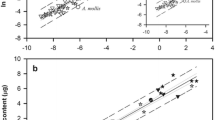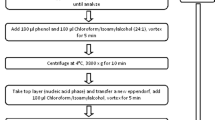Abstract
Naturally spawned and fertilized eggs of Atlantic halibut,Hippoglossus hippoglossus L., were analysed for protein, free amino acids (FAA), ammonium ions and energy content. The chemical composition was found to be size-dependent but varied little during egg development. Ammonium ions did, however, accumulate during the late embryonic stage, and the trend in FAA content was downward during the same period. Rates of O2 uptake and NH3 excretion followed exponential patterns. A total of 1µmol O2 was consumed and 120 nmol NH3 excreted between the time intervals of fertilization and 1 d post hatch. Derived O:N ratios indicated that the dominant portion of the energy metabolism was lipid- or carbohydrate-based during the mid-development period but switched to FAA as hatch was approached.
Similar content being viewed by others
Literature cited
Amberson, W. R., Armstrong, P. B. (1933). The respiratory metabolism ofFundulus heteroclitus during embryonic development. J. cell. comp. Physiol. 2: 387–397
Bell, M. V., Henderson, R. J., Pirie, B. J. S., Sargent, J. R. (1985). Effects of dietary polyunsaturated fatty acid deficiencies on mortality, growth and gill structure of turbot (Scophthalmus maximus L.). J. Fish Biol. 26: 181–191
Berg, L., Øiestad, V. (1986). Growth and survival studies of halibut (Hippoglossus hippoglossus L.) from hatching to beyond metamorphosis carried out in mesocosms. Int. Counc. Explor. Sea Comm. Meet. (Maricult. Comm.) F:16: 1–19
Blaxter, J. H. S. (1988). Pattern and variety in development. In: Hoar, W. S., Randall, D. J. (eds.) Fish physiology, Vol. XI A. Academic Press, New York, p. 1–58
Boulekbache, H. (1981). Energy metabolism in fish development. Am. Zool. 21: 377–389
Brafield, A. E. (1985). Laboratory studies of energy budgets. In: Tytler, P., Calow, P. (eds.) Fish energetics: new perspectives. Croom Helm, London, p. 257–281
Brett, J. R., Groves, T. D. D. (1979). Physiological Energetics. In: Hoar, W. S., Randall, D. J. (eds.) Fish physiology, Vol. VIII. Academic Press, New York, p. 279–281
Bull, H. B. (1971). An introduction to physical biochemistry, 2nd edn. F. A. Davis Company, Philadelphia
Cetta, C. M., Capuzzo, J. M. (1982). Physiological and biochemical aspects of embryonic and larval development of the winter flounder,Pseudopleuronectes americanus. Mar. Biol. 71: 327–337
Conover, R. J., Corner, E. D. S. (1968). Respiration and nitrogen excretion by some marine zooplankton in relation to their life cycles. J. mar. biol. Ass. U.K. 48: 49–75
Davenport, J., Lønning, S., Kjørsvik, E. (1983). Ammonia output by the eggs and larvae of the lumpsucker (Cyclopterus lumpus), the cod (Gadus morhua) and the plaice (Pleuronectes platessa). J. mar. biol. Ass. U.K. 63: 713–723
Devold, F. (1938). The North Atlantic halibut and net fishing. FiskDir. Skr. (Ser. Havunders.) 5 (6): 1–47
Ehrlich, K. F. (1974). Chemical changes during growth and starvation of larvalPleuronectes platessa. Mar. Biol. 24: 39–48
Falk-Peterson, S., Falk-Peterson, I. B., Sargent, J. R., Haug, T. (1986). Lipid class and fatty acid composition of eggs from Atlantic halibut (Hippoglossus hippoglossus). Aquaculture, Amsterdam 52: 207–211
Fraser, A. J., Gamble, J. C., Sargent, J. R. (1988). Changes in lipid content, lipid class composition and fatty acid composition of developing eggs and unfed larvae of cod (Gadus morhua). Mar. Biol. 99: 307–314
Fyhn, H. J. (1989). First feeding of marine fish larvae: Are free amino acids the source of energy? Aquaculture, Amsterdam 80: 111–120
Fyhn, H. J. (1990). Energy production in marine fish larvae with emphasis on free amino acids as a potential fuel. In: Mellinger, J., Truchot, J. P., Lahlou, B. (eds.) Comparative physiology: animal nutrition and transport processes. Karger, Switzerland, p. 176–192
Fyhn, H. J., Mangor-Jensen, A., Serigstad, B. (1986). Free amino acids in developing eggs and larvae of the cod. Basic studies and effects of oil. In: Fyhn, H. J. (ed.) Fish larval physiology and anatomy. Basic research and effects of oil. University of Bergen, Norway, p. 167–201
Fyhn, H. J., Serigstad, B. (1987). Free amino acids as energy substrate in developing eggs and larvae of the cod (Gadus morhua). Mar. Biol. 96: 335–341
Gatesoupe, F. J., Léger, C., Metailler, R., Luquet, P. (1977). Alimentation lipidique du turbot (Scophthalmus maximus L.): Influence de la longeur de chaine des acides gras de la serieω3. Annls Hydrobiol. 8: 89–97
Grasdalen, H., Jørgensen, L. (1985). In vivo NMR studies of fish eggs. Monitoring of metabolite levels, intracellular pH, and the freezing and permeability of water in developing eggs of plaice,Pleuronectes platessa L. Sarsia 72: 359–361
Green, E. J., Carritt, D. E. (1967). New tables for oxygen saturation of seawater. J. mar. Res. 25: 140–147
Hagenmeier, H. E., Smitz, I., Føhles, J. (1976). Zum Vorkommen von Isopeptidbindungen in der Eihülle der Regenbogenforelle (Salmo gairdneri Rich.). Hoppe-Seyler's Z. physiol. Chem. 357: 1436–1438
Harvey, H. W. (1966). The chemistry and fertility of sea waters, 2nd edn. Cambridge University Press, Cambridge
Haug, T. (1990) Biology of the Atlantic halibut,Hippoglossus hippoglossus (L., 1758). A review. Adv. mar. Biol. 26: 1–70
Haug, T., Kjørsvik, E., Solemdal, P. (1984). Vertical distribution of Atlantic halibut (Hippoglossus hippoglossus) eggs. Can. J. Fish. aquat. Sciences 41: 798–804
Haug, T., Ringø, E., Pettersen, G. W. (1988). Total lipid and fatty acid composition of polar and neutral lipids in different tissues of Atlantic Halibut (Hippoglossus hippoglossus L.) eggs. Sarsia 73: 163–168
Helvik, J. V. (1988). Klekkeprosessen hos kveite (Hippoglossus hippoglossus L.). Cand. scient. thesis. University of Bergen, Norway (In Norwegian)
Henderson, R. J., Sargent, J. R. (1985). Fatty acid metabolism in fish. In: Cowey, C. B., Mackie, A. M., Bell, J. G. (eds.) Nutrition and feeding in fish. Academic Press, New York, p. 349–364
Hollett, A., Hayes, F. R. (1946). Protein and fat of the salmon egg as sources of energy for the developing embryo. Can. J. Res. (Ser. D) 24: 39–50
Howell, B. R., Scott, A. P. (1988). Ovulation cycles and post-ovulatory deterioration of eggs to turbot (Scophthalmus maximus L.) Rapp. P.-v. Réun. Cons. int. Explor. Mer 191: 21–26
Kjesbu, O. S. (1989). The spawning activity of cod,Gadus morhua L. J. Fish. Biol. 34: 195–206
Kjørsvik, E., Mangor-Jensen, A., Holmefjord, I. (1990) Egg quality in marine fishes. Adv. mar. Biol. 26: 71–113
Léger, C., Gatesoupe, F. J., Metailler, R., Luquet, P., Fremont, L. (1979). Effect of dietary fatty acids differing by chain lengths on the growth and lipid composition of the turbot (Scophthalmus maximus L.). Comp. Biochem. Physiol. 64B: 345–350
Lowry, O. H., Rosebrough, N. J., Farr, A. L., Randall, R. J. (1951). Protein measurement with the folin phenol reagent. J. Biol. Chem. 193: 265–275
Mangor-Jensen, A. (1987). Water balance in developing eggs of the cod,Gadus morhua L. Fish Physiol. Biochem. 3: 17–24
Mangor-Jensen, A., Jelmert, A. (1986). The effect of ambient salinity on the buoyancy of eggs from the Atlantic halibut (Hippoglossus hippoglossus). Int. Counc. Explor. Sea Comm. Meet. (Maricult. Comm.) F:52: 1–7
McCracken, F. D. (1958). On the biology and fishery of the Canadian Atlantic halibut,Hippoglossus hippoglossus L. J. Fish. Res. Bd Can. 15: 1269–1311
McEvoy, L. A. (1984). Ovulatory rhythms and over-ripening of eggs in cultivated turbot,Scophthalmus maximus L. J. Fish Biol. 24: 437–448
McIntyre, A. D. (1952). Statistics of the Scottish halibut fishery 1930–1949. Mar. Res. 1952(1): 1–24
Oppen-Berntsen, D. O. (1990). Oogenesis and hatching in teleostan fishes with special reference to eggshell proteins. Dr. scient. thesis, University of Bergen, Norway
Oppen-Berntsen, D. O., Helvik, J. V., Walther, B. T. (1990). The major structural proteins of cod (Gadus morhua) eggshell and protein crosslinking during teleost egg hardening. Devl Biol. 137: 258–265
Owen, M., Adron, J. W., Middleton, C., Cowey, C. B. (1975). Elongation and desaturation of dietary fatty acids in turbot (Scophthalmus maximus L.) and rainbow trout (Salmo gairdneri L.). Lipids 10: 528–531
Phillipson, J. (1964). A miniature bomb calorimeter for small biological samples. Oikos 15: 130–139
Prus, T. (1975). Measurement of calorific value using Phillipson microbomb calorimeter. In: Crodzinki, W., Klekowski, R. Z., Duncan, C. (eds.) Ecological energetics. IBP Handbook 24. Blackwell Scientific Publications, Oxford, p. 149–160
Riis-Vestergaard, J. (1982). Water and salt balance of halibut eggs and larvae (Hippoglossus hippoglossus). Mar. Biol. 70: 135–139
Rollefsen, G. (1934). The eggs and larvae of the halibut (Hippoglossus vulgaris). K. norske Vidensk. Selsk. Skr. 7: 20–23
Rønnestad, I., Knutsen, H. (in press). Flow injection analysis in marine aquacultural research: ammonia excretion in marine fish larvae. In focus: the Tecator journal of technology for chemical analysis, Vol. 14. Tecator AB, Höganäs, Sweden
Rutter, W. J. (1967). Protein determinations in embryos. In: Witt, F. H., Wessels, N. K. (eds.) Methods in developmental biology. Academic Press, New York, p. 671–684
Scott, A. P., Middleton, C. (1979). Unicellular algae as food for turbot (Scophthalmus maximus L.) larvae — importance of dietary long-chain polyunsaturated fatty acids. Aquaculture, Amsterdam 18: 227–240
Serigstad, B. (1987). Oxygen uptake of developing fish eggs and larvae. Sarsia 72: 369–371
Smith, S. (1952). Studies in the development of the rainbow trout (Salmo gairdneri Richardson). II. The metabolism of carbohydrates and fats. J. exp. Biol. 29: 650–666
Sokal, R. R., Rohlf, F. J. (1981). Biometry. The principles and practice of statistics in biological research, 2nd edn. W. H. Freeman & Co., San Francisco
Solemdal, P., Tilseth, S., Øiestad, V. (1974). Rearing and halibut: incubation and the early larval stages. Int. Counc. Explor. Sea Comm. Meet. (Maricult. Comm.) F:41: 1–5
Solórzano, L. (1969). Determination of ammonia in natural waters by the phenolhypochlorite method. Limnol. Oceanogr. 14: 799–801
Tytler, P., Blaxter, J. H. S. (1988). Drinking in yolk-sac stage larvae of the halibut,Hippoglossus hippoglossus (L.). J. Fish Biol. 32: 493–494
Watanabe, T. (1982). Lipid nutrition in fish. Comp. Biochem. Physiol. 73B(1): 3–15
Yamagami, K. (1988). Mechanism of hatching in fish. In: Hoar, W. S., Randall, D. J. (eds.) Fish physiology, Vol. XIA. Academic Press, New York, p. 447–449
Yamamoto, T. S. (1984). Ammonia release by chum salmon eggs at the initiation of their embryonic development. Dev. Growth Differentiation 26: 95–104
Author information
Authors and Affiliations
Additional information
Communicated by T. Fenchel, Helsingør
Correspondence should be addressed to: Zoological Laboratory, University of Bergen, Allégt. 41, N-5007 Bergen, Norway
Rights and permissions
About this article
Cite this article
Finn, R.N., Fyhn, H.J. & Evjen, M.S. Respiration and nitrogen metabolism of Atlantic halibut eggs (Hippoglossus hippoglossus). Mar. Biol. 108, 11–19 (1991). https://doi.org/10.1007/BF01313466
Accepted:
Issue Date:
DOI: https://doi.org/10.1007/BF01313466




